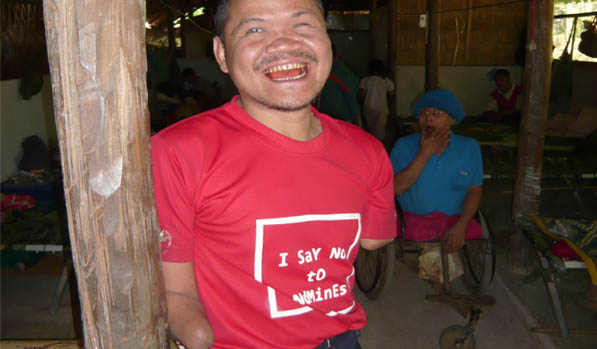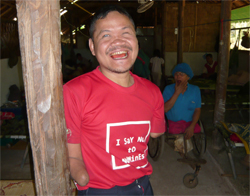Surviving on a Little Hope and 33 US Cents a Day

Some have no legs. Others lack hands or arms. About half are blind. But all these landmine victims have one vital faculty in common—a voice. And what a voice!
The teak rafters of their ramshackle quarters in Thailand’s Mae La refugee camp seem to tremble as they belt out Karen songs in an impromptu concert for a group of foreign visitors.
 |
More than a dozen landmine victims, scarred by Burma’s long-running war between the Karen National Union and the Burmese Army, are housed in this section of Thailand’s largest refugee camp, Mae La.
“They love to sing,” said our Karen guide. “What else is left for them apart from music?”
Mae La is a small city of more than 40,000 people, housed in teak and bamboo dwellings—some of them little more than huts—crammed into a 4 square km, mountainous corner of Thailand’s Tak province, 57 km (34 mi) from the Thai-Burmese border town of Mae Sot.
In other circumstances, this would be a beautiful spot. The jungle-clad valley is overlooked by dramatic mountain peaks that hold a visitor in awe. But fear, not awe, is what the people of Mae La feel when they contemplate those mountains, which mark the border with Burma, just 8 km (5 mi) to the west.
Twice in its 25 year history, Mae La has come under attack by Burmese regulars and forces of the regime-backed Democratic Karen Buddhist Army. There’s no guarantee that the Thai Army would rush to Mae La’s defense should Burma again train its guns on this symbol of resistance to tyranny.
For now, the only Thai military presence in evidence near the camp are the Rangers who man checkpoints on the main access road from Mae Sot. Thailand leaves it to the hand of charity to care for the refugees of Mae La.
Eleven international non-government agencies, grouped under the direction of the Thai Burma Border Consortium (TBBC), finance Mae La and 10 other camps, providing food, shelter and essential services for more than 148,000 refugees, on an annual budget of US $23 million.
Soaring commodity prices, a strengthening Thai baht and the pressures on donors because of the global financial crisis have taken a heavy toll on the work of the TBBC, which now fights on a daily basis to keep its refugees adequately fed and healthy.
The meager rations allotted daily to each refugee have been cut, and such small luxuries as soap have been dropped altogether. Even mosquito nets, essential items in primitive homes with unglazed windows and patched walls and roofs, are in short supply.
The daily basket of provisions contains just enough to meet the minimum energy intake for healthy living—2,100 calories. There’s only room in the tight budget for rations costing a total of less than 12 baht (33 US Cents) per head—rice, flour (fortified with minerals and vitamins), fish paste, protein-rich mung beans, cooking oil, salt, sugar and dried chilies. That’s it—no meat, fresh fish or any of the small delicacies taken for granted in the Thai villages that dot this verdant part of western Thailand.
Exceptions are made for undernourished children, pregnant women and nursing mothers, hospital patients and people suffering from HIV-AIDS and TB. Their diet is supplemented by eggs, milk powder, fresh fruit and vegetables.
Our party, led by Sally Steen of the British-based charity Projects to Support Refugees from Burma, brought sweet biscuits, some other simple treats, soap and coffee. As we left, the tables had been laid for lunch—individual plates of the freshly unpacked biscuits, each with a plastic beaker of water.
The grinding routine and the boredom of camp life take their toll on family life. Suicides are no rarity and domestic violence is a common problem.
Yet rays of hope do penetrate the dusty pall of poverty that hangs over the camp. Schools somehow manage against all the odds to offer young people an education that could provide them with the opportunity to exchange camp life for a worthwhile existence in the outside world.
A resettlement program was approved by the Thai government in 2005, and by July 2008 more than 14,000 Mae La residents had left for new lives abroad, most of them in the US.
1 | 2 next page »
- 'My Wife Died From Police Abuse,' Says Husband
- US Says Observer Conditions Don't Meet Int'l Standards
- 159 Observers to Monitor Burma Election
- Govt to Address Breaches of SSA-South Ceasefire: Aung Min
- Burma Investors Pin Hopes on Seminal Sunday
- Malaysia PM Leads 50-Strong Delegation to Burma
- US Congress to Assess Burma's Political Prisoner Issue
- Rangoon Woman in Police Station Death Plunge
- Burmese Legal System Remains Tool of Govt: AHRC
- Burmese Army Chief Defends Political Role
